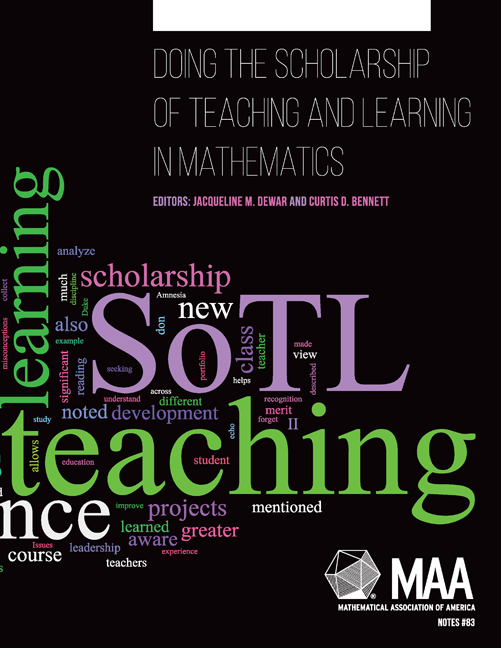Book contents
- Frontmatter
- Contents
- Foreword
- Preface
- Part I Getting Started in SoTL as a Mathematician
- Part II Illustrations of SoTL Work in Mathematics
- Theme 1: Experiments with Approaches to Teaching
- Theme 2: Crafting Learning Experiences around Real-World Data or Civic Engagement
- Theme 3: Using Assigned Reading Questions to Explore Student Understanding
- 13 Conceptual or Computational? Making Sense of Reading Questions in an Inverted Statistics Course
- 14 An Investigation Into the Effectiveness of Pre-Class Reading Questions
- Theme 4: Exploring Student Understanding of the Nature of Mathematics
- Theme 5: Tackling Large Questions
- Epilogue
- Index
13 - Conceptual or Computational? Making Sense of Reading Questions in an Inverted Statistics Course
from Theme 3: - Using Assigned Reading Questions to Explore Student Understanding
- Frontmatter
- Contents
- Foreword
- Preface
- Part I Getting Started in SoTL as a Mathematician
- Part II Illustrations of SoTL Work in Mathematics
- Theme 1: Experiments with Approaches to Teaching
- Theme 2: Crafting Learning Experiences around Real-World Data or Civic Engagement
- Theme 3: Using Assigned Reading Questions to Explore Student Understanding
- 13 Conceptual or Computational? Making Sense of Reading Questions in an Inverted Statistics Course
- 14 An Investigation Into the Effectiveness of Pre-Class Reading Questions
- Theme 4: Exploring Student Understanding of the Nature of Mathematics
- Theme 5: Tackling Large Questions
- Epilogue
- Index
Summary
Editors' Commentary
In this chapter Derek Bruff describes his project, trying to get students to read a mathematics textbook more effectively. His report discusses working with existing data, identifying patterns within qualitative data, and trying to approximate a control group experiment within a single course. He also obtained a surprising result that has implications for the teaching of conceptual and computational material in statistics courses. He tells us that his overall plan was inspired by a SoTL project by Axtell and Turner (2006), who have a chapter on that work in this book (Chapter 14). This illustrates a key tenet of SoTL – that work should be made public so that others can build on it. His project also illustrates the interplay between the What is? and What works? questions in the SoTL taxonomy.
Introduction
While teaching an introduction to statistics for undergraduate engineering majors, I asked my students to read their textbooks before class. I held them accountable by giving pre-class reading quizzes consisting of two or three open-ended questions about the reading and a “muddiest point” question that asked students what they had found most difficult or confusing in the reading. I wanted my students to come to class familiar enough with the course content so that they could spend class time on activities designed to foster deep learning of the material. After my first semester teaching in this way, I wondered what kind of material my students were able to learn before class from reading their textbook. I also wondered if there were types of pre-class reading quizzes that might help my students learn more from their textbook so that we could progress even further with the material during class. This led me to analyze my students' responses to the pre-class reading questions and eventually to conduct a quasi-control group experiment.
During my investigation I faced the challenges of working with existing data, of identifying patterns in qualitative data, and of conducting something approximating a control group experiment within a single course.
- Type
- Chapter
- Information
- Doing the Scholarship of Teaching and Learning in Mathematics , pp. 127 - 136Publisher: Mathematical Association of AmericaPrint publication year: 2014

